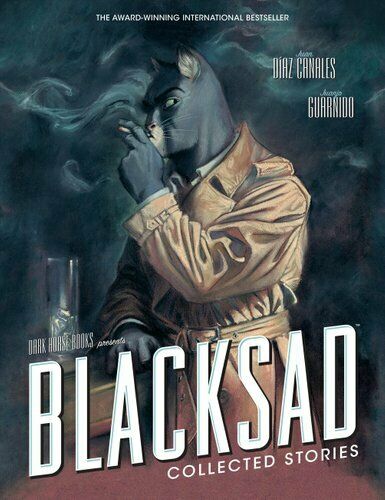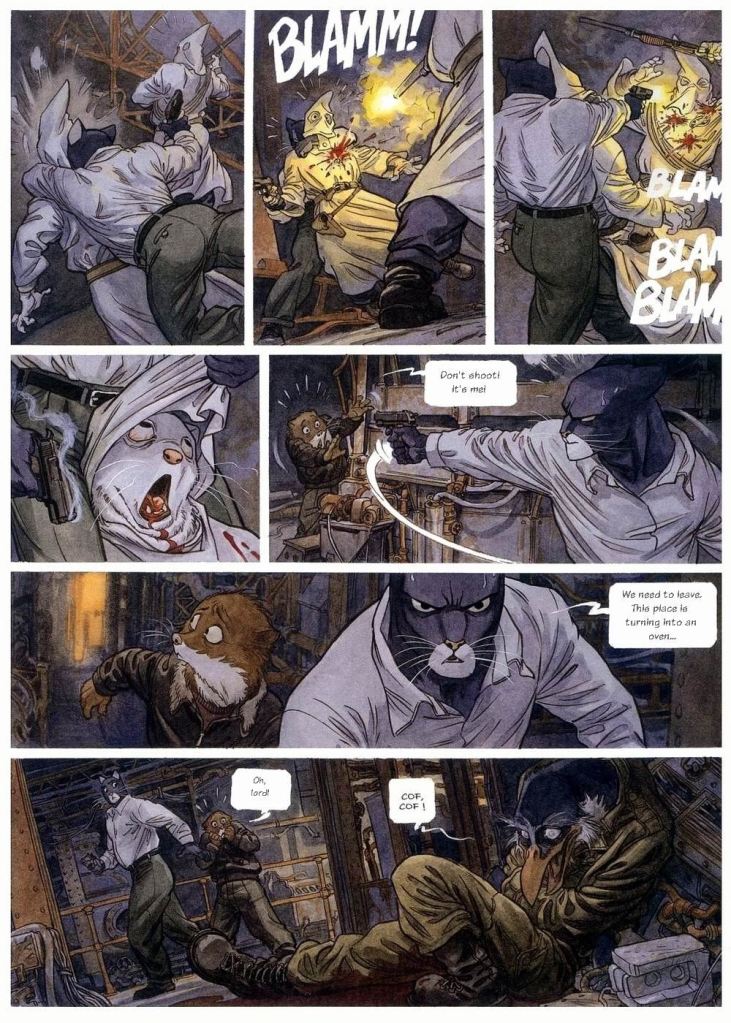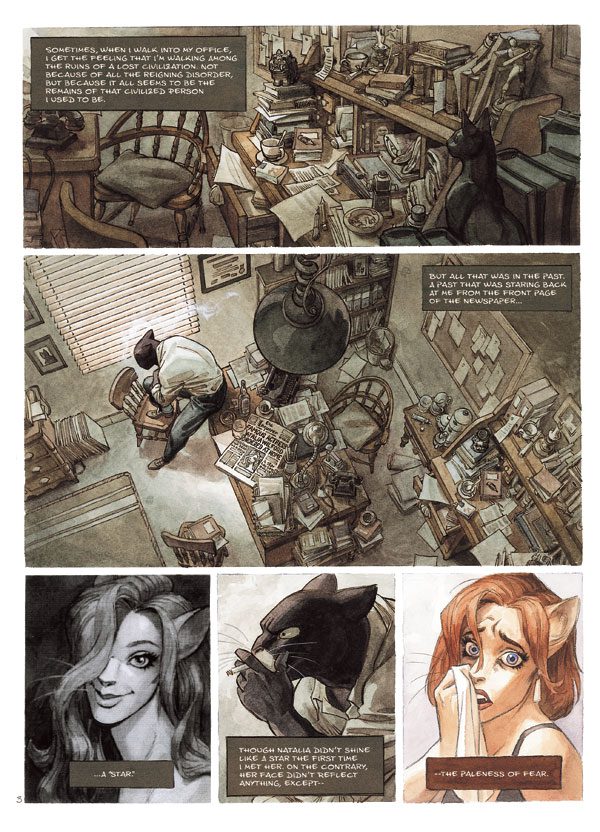
Synopsis
The classic hardboiled noir series featuring beloved anthropomorphic cat detective, John Blacksad, celebrates its twentieth year. Readers will now be able to experience five of Blacksad’s biggest cases in a single comprehensive volume with new sketchbook material never published in English. Blacksad is constantly up to his ears in trouble. Sticking his nose into mystery after mystery, often getting involved with women almost as dangerous as the criminals he thwarts. Be it solving the murder of a famous actress or keeping nuclear weapons out of terrorist hands, Blacksad’s grim work often provides a mirror for real world conflict and human issues, never turning a blind eye to racism, political tensions, or brutally sudden violence. Canales and Guarnido redefine the standards for graphic storytelling, carving striking characters that are both animalistic and intimately human. Guarnido’s sumptuously painted pages and rich cinematic style bring the world of 1950s America to life, earning high praise from comics legends like Will Eisner, Stan Lee, Jim Steranko, and Tim Sale! This volume collects the following Blacksad stories: Somewhere Within the Shadows, Arctic Nation, Red Soul, A Silent Hell, Amarillo; and the comic shorts Spit at the Sky and Like Cats and Dogs.
Review
Enter a world of crime and mystery, full of criminal rats, jazz-playing gorillas and rhino gangsters—feline private eye John Blacksad is on the case.
I love me a good detective story, and I love me some good comics, so my excitement was off the charts when I discovered Juan Díaz Canales and Juanjo Guardino’s Blacksad comic series. Now, a quick disclaimer: I was a big fan of anthropomorphism—the personification of animals. Past childhood franchises (Winnie the Pooh, Hamtaro, Micky Mouse, Looney Tunes and the like) were great, but Brian Jacques’ Redwall book series was my jam. Seriously, I loved them and read all twenty-two(!!!) books. In adulthood though, I’ve never actively sought out the stuff. But, Blacksad has convinced me that when done well—instead of being an easily overplayed gimmick—it can be a powerful allegory for the real world, past and present. It can also be aimed at and work well for adults.

Despite being skeptical at first, I am firmly a fan after reading the five main volumes of the Blacksad comic series: Somewhere Within the Shadows, Arctic Nation, Red Soul, A Silent Hell, and Amarillo. Compiled in Blacksad: The Collected Stories, each volume offers up something unique (a location, characters, and themes), as well as a storyline that reflects real-world issues. Meanwhile, there are glimpses into the past of the hardboiled feline protagonist, John Blacksad, and recurring characters that work as foils for his gruff (but increasingly empathetic) personality. The art style is also incredible, with artists Juanjo Guardino crafting a painterly world that evokes the mood and aesthetics of post-WWII America. All these things combined, the series tackles heavy stuff (drug addiction, racism, love, fame, nuclear weapons, to name a few) while also providing engaging characters that grow as the series progresses. The stories are fascinating, the visuals are beautiful, but Blacksad himself is what kept me reading. He’s a cat, yes, in a world full of animals, but he’s a flawed creature that plays with many of the hardboiled genre’s overdone tropes—plus, he (almost) always lands on his feet.
I won’t go too much further, so as to avoid spoiling any of the specific storylines, but I was thoroughly impressed with the Blacksad series. It brings together so many things that I love: jazz, detective and mystery thrillers, history (specifically the Cold War) and much more. On top of that, the anthropomorphism allegory works well, with certain animals often reflecting the true nature of the character they represent (think a deceitful snake or a stubborn bull). But those preconceived assumptions about an animal and its “personality” are also used to subvert us as readers into pigeonholing a character, only to have those assumptions flipped on us. It’s a great use of the personified animal device, elevated through the evocative artwork.

Speaking of which, the art is top-notch across the board. Utilizing a watercolor/painterly style, it is implemented incredibly well across the series, carrying each volume with just the right use of color palette and atmosphere. Each story feels like it fits into the time period and location because of the art, and the dialogue, characterization and plots extend naturally from this. Arctic Nation, for example, stands out for its stark contrast of whiteness (snow and naturally white animals) and red motifs. This visual distinction makes the white supremacist angle of its story even more powerful. And then there’s Amarillo, the fifth volume, which uses its name (yellow in Spanish) as a visual through-line of its narrative—namely a yellow car that serves as a main driver (ha ha) of that narrative. Paired with the scorching deserts of the American Southwest, the yellow design creates a brightness and mood that heightens the darkness of the underlying story.
All in all, the Blacksad series was a treat for my eyes and mind. It was intriguing, visually and narratively, with genuine surprises and a colorful cast of characters. The main protagonist, John Blacksad, was also given his due, continuously pushed to the edge of his abilities and given opportunities to show both his inner violence and humanity. (Does humanity make sense when he’s a cat?) After five satisfying volumes, which I burned through far too fast, I’m left wanting more from Blacksad. But, on the other hand, I am completely happy with what I have experienced in this fictional world. John Blacksad and his furry feline adventures will remain in my mind as something purely positive, and I’m content with that.
This review was originally published on the Mind & Musings blog.








Leave a Reply